Characteristics and Synoptic Patterns of Regional Extreme Rainfall over the Central and Eastern Tibetan Plateau in Boreal Summer
Abstract
1. Introduction
2. Datasets and Methods
2.1. Datasets
2.2. Definition of the Thresholds of Extreme Rainfall Events
2.3. Mann–Kenda (M-K) Test
3. Results
3.1. Spatiotemporal Distribution Characteristics of Extreme Precipitation over the TP
3.1.1. Spatial Distribution Characteristics of Extreme Precipitation
3.1.2. Temporal Distribution Characteristics of Extreme Precipitation
3.2. Mechanism of Extreme Precipitation in Different Regions over the TP
3.2.1. Influence of Regional Extreme Precipitation Events
3.2.2. Characteristics of Atmospheric Circulation
3.2.3. Characteristics of Dynamic Field
3.2.4. Characteristics of Thermal Field
3.2.5. Characteristics of Water Vapor
4. Discussion and Conclusions
4.1. Discussion
4.2. Conclusions
Author Contributions
Funding
Institutional Review Board Statement
Informed Consent Statement
Data Availability Statement
Acknowledgments
Conflicts of Interest
References
- Goswami, B.N.; Venugopal, V.; Sengupta, D.; Madhusoodanan, M.S.; Xavier, P.K. Increasing trend of extreme rain events over India in a warming environment. Science 2006, 314, 1442–1445. [Google Scholar] [CrossRef]
- Giannaros, C.; Kotroni, V.; Lagouvardos, K.; Oikonomou, C.; Haralambous, H.; Papagiannaki, K. Hydrometeorological and Socio-Economic Impact Assessment of Stream Flooding in Southeast Mediterranean: The Case of Rafina Catchment (Attica, Greece). Water 2020, 12, 2426. [Google Scholar] [CrossRef]
- Jiang, W.X.; Li, G.P.; Yang, S.; Yang, K.; Chen, J.W. Interannual variation of summer atmospheric heat source over the tibetan plateau and the role of convection around the western maritime continent. J. Clim. 2016, 29, 121–138. [Google Scholar] [CrossRef]
- Cao, L.; Pan, S. Changes in precipitation extremes over the “Three-River Headwaters”region, hinterland of the Tibetan Plateau, during 1960–2012. Quat. Int. 2014, 321, 105–115. [Google Scholar] [CrossRef]
- Ning, B.; Yang, X.; Chang, L. Changes of temperature and precipitation extremes in Hengduan Mountains, Qinghai-Tibet Plateau in 1961–2008. Chin. Geogr. Sci. 2012, 22, 422–436. [Google Scholar] [CrossRef]
- You, Q.; Kang, S.; Aguilar, E.; Yan, Y.P. Changes in daily climate extremes in the eastern and central Tibetan Plateau during 1961–2005. J. Geophys. Res. Atmos. 2008, 113, 1639–1647. [Google Scholar] [CrossRef]
- Singh, P.; Makamura, K. Diurnal variation in summer precipitation over the central Tibetan Plateau. J. Geophys. Res. Atmos. 2009, 114, D20. [Google Scholar] [CrossRef]
- Wu, X.G.; Duan, A.M.; Zhang, X.Q.; Liu, Y.M.; Ma, Y.M.; Yang, K. Extreme weather and climate changes and its environmental effects over the Tibetan Plateau. Chin. J. Nat. 2013, 35, 167–171. (In Chinese) [Google Scholar]
- Liu, D.X.; Yin, Z.Y. Spatial and temporal variation of summer precipitation over the eastern Tibetan Plateau and the North Atlantic oscillation. J. Clim. 2001, 14, 2896–2909. [Google Scholar] [CrossRef]
- Wu, P.; Kimura, F.; Sasaki, T.; Liu, J.; Yamanaka, M.D. Diurnal variation of GPS-derived precipitable water over the Tibetan Plateau during summer. J. Appl. Meteorol. 2003, 5, 02620. [Google Scholar]
- Wu, S.H.; Yin, Y.H.; Zheng, D.; Yang, Q.Y. Climatic trends over the Tibetan Plateau during 1971–2000. J. Geogr. Sci. 2007, 17, 141–151. [Google Scholar] [CrossRef]
- Bao, X.; Zhang, F.; Sun, J. Diurnal Variations of Warm-Season Precipitation East of the Tibetan Plateau over China. Mon. Weather Rev. 2011, 39, 2790–2810. [Google Scholar] [CrossRef]
- Wu, Y.; Huang, A.; Huang, D.; Chen, F.; Yang, B.; Zhou, Y.; Fang, D.; Zhang, L.J.; Wen, L.J. Diurnal variations of summer precipitation over the regions east to Tibetan Plateau. Clim. Dyn. 2017, 51, 4287–4307. [Google Scholar] [CrossRef]
- Ji, Q.; Yang, J.P.; Chen, H.J. Comprehensive analysis of the precipitation changes over the Tibetan Plateau during 1961–2015. J. Glaciol. Geocryol. 2018, 40, 1090–1099. (In Chinese) [Google Scholar]
- Yang, Z.G.; Jian, J.; Hong, J.C. Temporal and Spatial Distribution of Extreme recipitation Events in Tibet during 1961–2010. Plateau Meteorol. 2014, 33, 37–42. (In Chinese) [Google Scholar]
- Du, J.; Lu, H.Y.; Jian, J. Change in Extreme Precipitation Events over Tibet from 1961 to 2012. J. Nat. Resour. 2014, 29, 990–1001. (In Chinese) [Google Scholar]
- Yang, Y.; Du, J.; Luo, S.X.; Shi, L. On Extreme Precipitation Events in the Nujiang River Basin in Tibet in Recent 40 Years. Arid Zone Res. 2013, 30, 315–321. (In Chinese) [Google Scholar]
- Li, H.M.; Li, L.; Zhang, J.X.; Shi, X.H.; Shen, H.Y.; Wang, Z.N. Changes in extreme climatic events over the sources of the three rivers in the prometaphase 21 st century. J. Glaciol. Geocryol. 2012, 34, 1403–1408. (In Chinese) [Google Scholar]
- Lu, H.Y.; Du, L.; Yuan, J.; Liao, J. Variation characteristics of extreme precipitation events over Mt. Qomolangma region in China from 1971 to 2012. J. Glaciol. Geocryol. 2014, 36, 563–572. [Google Scholar]
- Agel, L.; Barlow, M.; Qian, J.-H.; Colby, F.; Douglas, E.; Eichler, T. Climatology of daily precipitation and extreme precipitation events in the northeast United States. J. Hydrometeorol. 2015, 16, 2537–2557. [Google Scholar] [CrossRef]
- Frei, A.; Kunkel, K.E.; Matonse, A. The seasonal nature of extreme hydrological events in the northeastern united states. J. Hydrometeorol. 2015, 16, 2065–2085. [Google Scholar]
- Huang, H.; Winter, J.M.; Osterberg, E.C.; Horton, R.M.; Beckage, B. Total and extreme precipitation changes over the northeastern United States. J. Hydrometeorol. 2017, 18, 1783–1798. [Google Scholar] [CrossRef] [PubMed]
- Greco, A.; De Luca, D.L.; Avolio, E. Heavy Precipitation Systems in Calabria Region (Southern Italy): High-Resolution Observed Rainfall and Large-Scale Atmospheric Pattern Analysis. Water 2020, 12, 1468. [Google Scholar] [CrossRef]
- Macy, E.H.; Thorncroft, C.D.; Bosar, L.F. Changes in Extreme Precipitation in the Northeast United States: 1979–2014. J. Hydrometeorol. 2019, 20, 673–688. [Google Scholar]
- Sun, J.C.; Guan, Z.Y.; Li, M.G.; Yu, Y.X. Anomalous circulation patterns in association with two types of regional daily precipitation extremes over South China from July to October. Acta Meteorol. Sin. 2019, 77, 43–57. (In Chinese) [Google Scholar]
- Yang, S.; Li, Q. Improvement in homogeneity analysis method and update of China precipitation data. Adv. Clim. Chang. Res. 2014, 10, 276–281. (In Chinese) [Google Scholar]
- Dee, D.P.; Uppala, S.M.; Simmons, A.J.; Berrisford, P.; Poli, P.; Kobayashi, S.; Andrae, U.; Balmaseda, G.; Bauer, P.; Bechtold, P.; et al. The ERA-Interim reanalysis: Configuration and performance of the data assimilation system. Q. J. R. Meteorol. Soc. 2011, 137, 553–597. [Google Scholar] [CrossRef]
- Easterling, D.R.; Meehl, G.A.; Changnon, C.P.A.; Karl, T.R.; Mearns, L.O. Climate extremes: Observations, modeling and impacts. Science 2000, 289, 2068–2074. [Google Scholar] [CrossRef]
- Torrence, C.; Compo, G.P. A practical guide to wavelet analysis. Bull. Am. Meteorol. Soc. 1998, 79, 61–78. [Google Scholar] [CrossRef]
- Wang, W.-S.; Ding, J.; Li, Y.-Q. Hydrology Wavelet Analysis; Chemical Industry Press: Beijing, China, 2005. (In Chinese) [Google Scholar]
- Gao, S.T. The Instability of the Vortex Sheet along the Shear Line. Adv. Atmos. Sci. 2000, 17, 526–537. [Google Scholar]
- He, G.B.; Gao, W.L.; Tu, N.N. The Observational Analysis of Shear Line and Low Vortex over the Tibetan Plateau in Summer from 2000 to 2007. Plateau Meteorol. 2009, 28, 37–42. (In Chinese) [Google Scholar]
- Fu, Y.F.; Liu, X.P.S.; Li, R.; Zhong, L. Characteristics of precipitation based on cloud brightness temperatures and storm tops in summer Tibetan Plateau. Chin. J. Atmos. Sci. 2016, 40, 102–120. (In Chinese) [Google Scholar]
- He, G.B.; Shi, R. Studies on dynamic and thermal characteristics of different shear lines over Tibetan Plateau in summer. Plateau Meteorol. 2011, 30, 568–575. (In Chinese) [Google Scholar]
- Li, G.P.; Li, S.S.; Huang, C.H. Research status and prospect of the interaction between Tibetan Plateau shear line and Tibetan Plateau vortex. J. Adv. Earth Sci. 2017, 32, 919–925. (In Chinese) [Google Scholar]
- Xie, X.R.; You, Q.L.; Bao, Y.T.; Meng, X.H. The connection between the precipitation and water vapor transport over Qing-hai-Tibetan Plateau in summer based on the multiple datasetssets. Plateau Meteorol. 2018, 37, 78–92. (In Chinese) [Google Scholar]
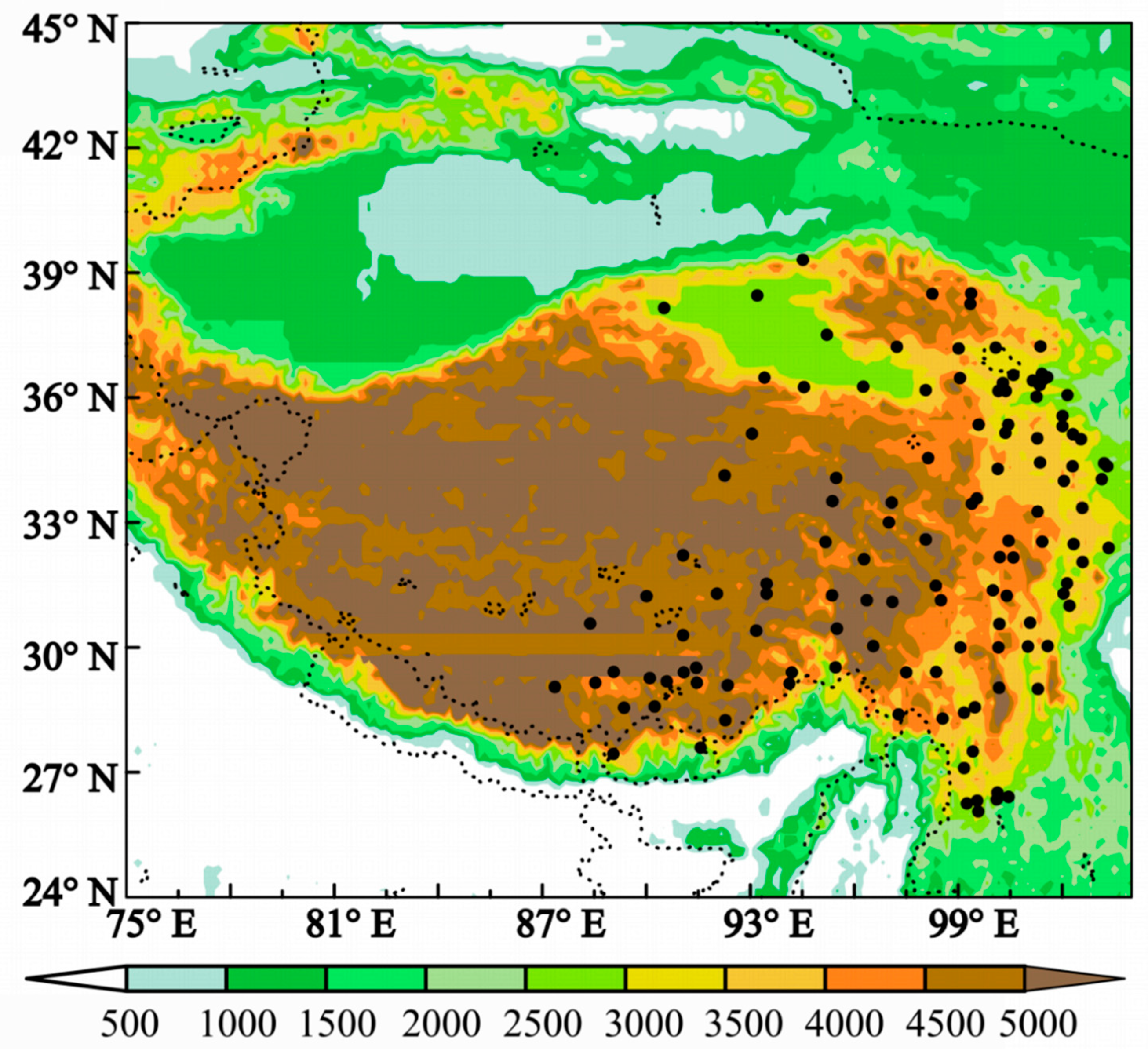

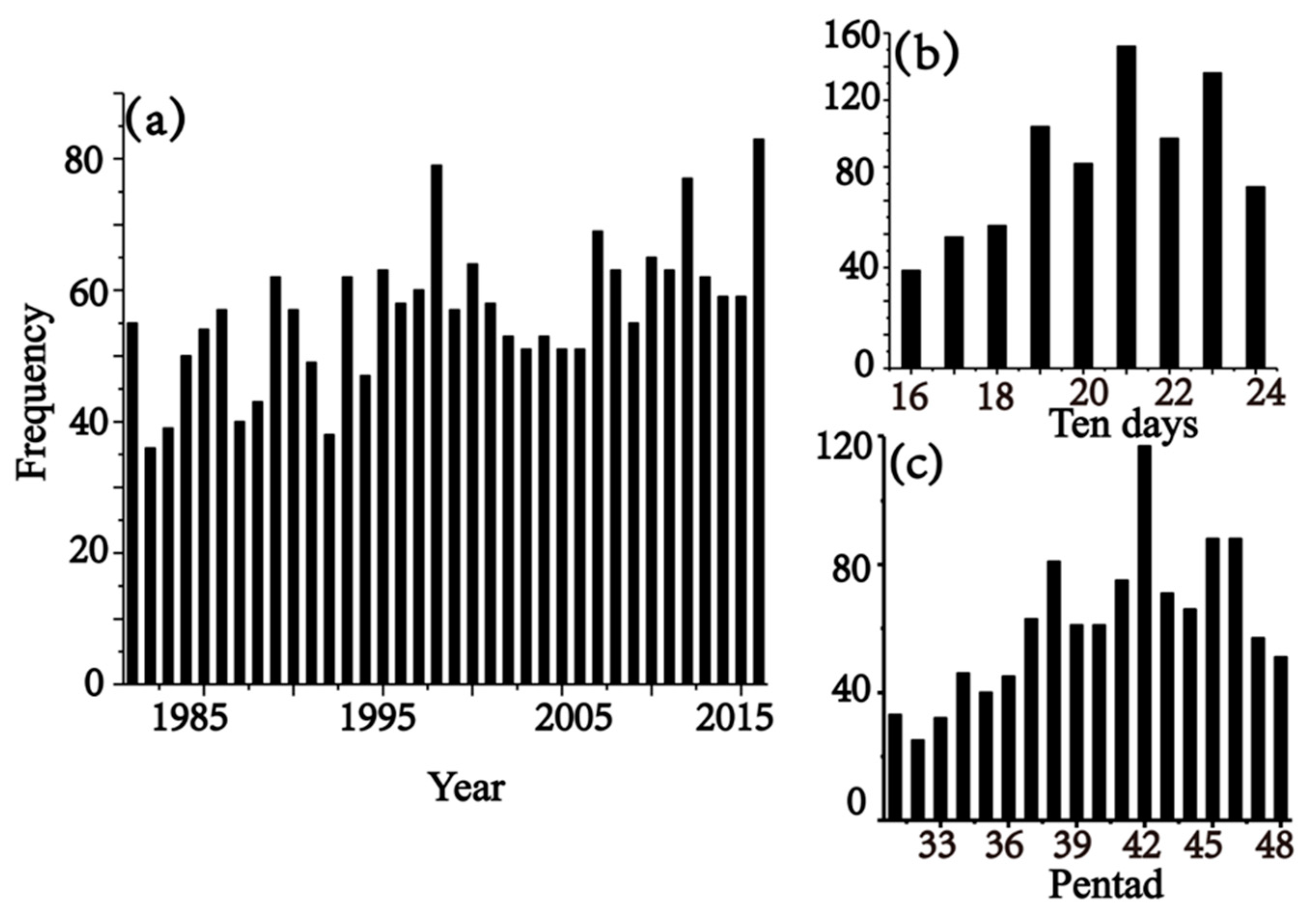

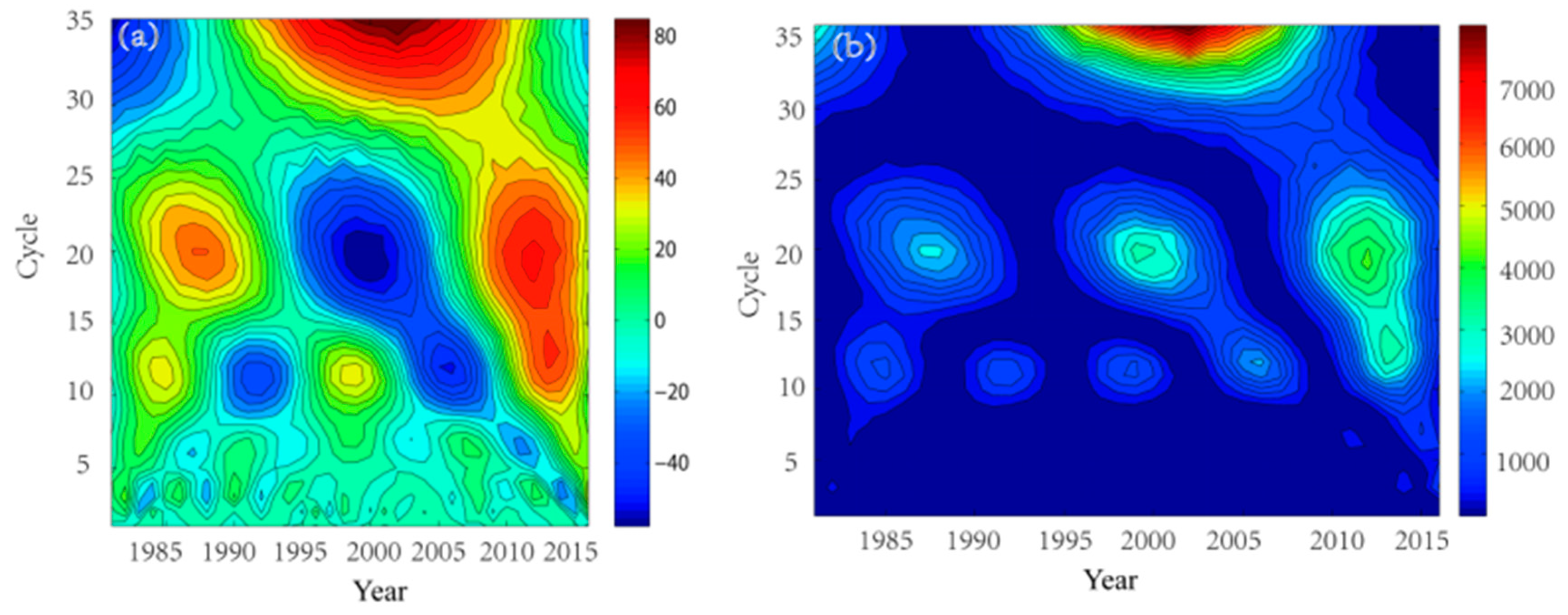


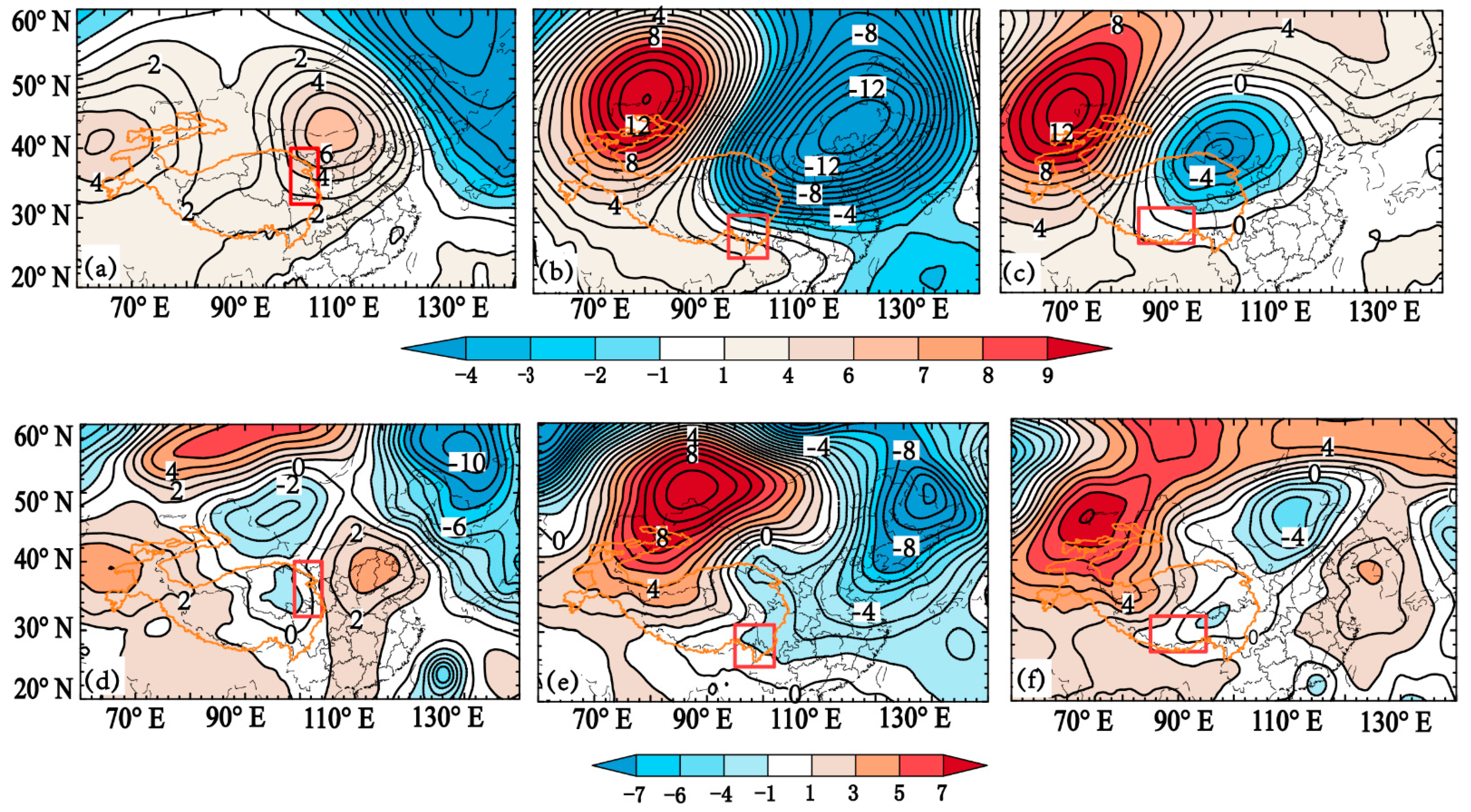
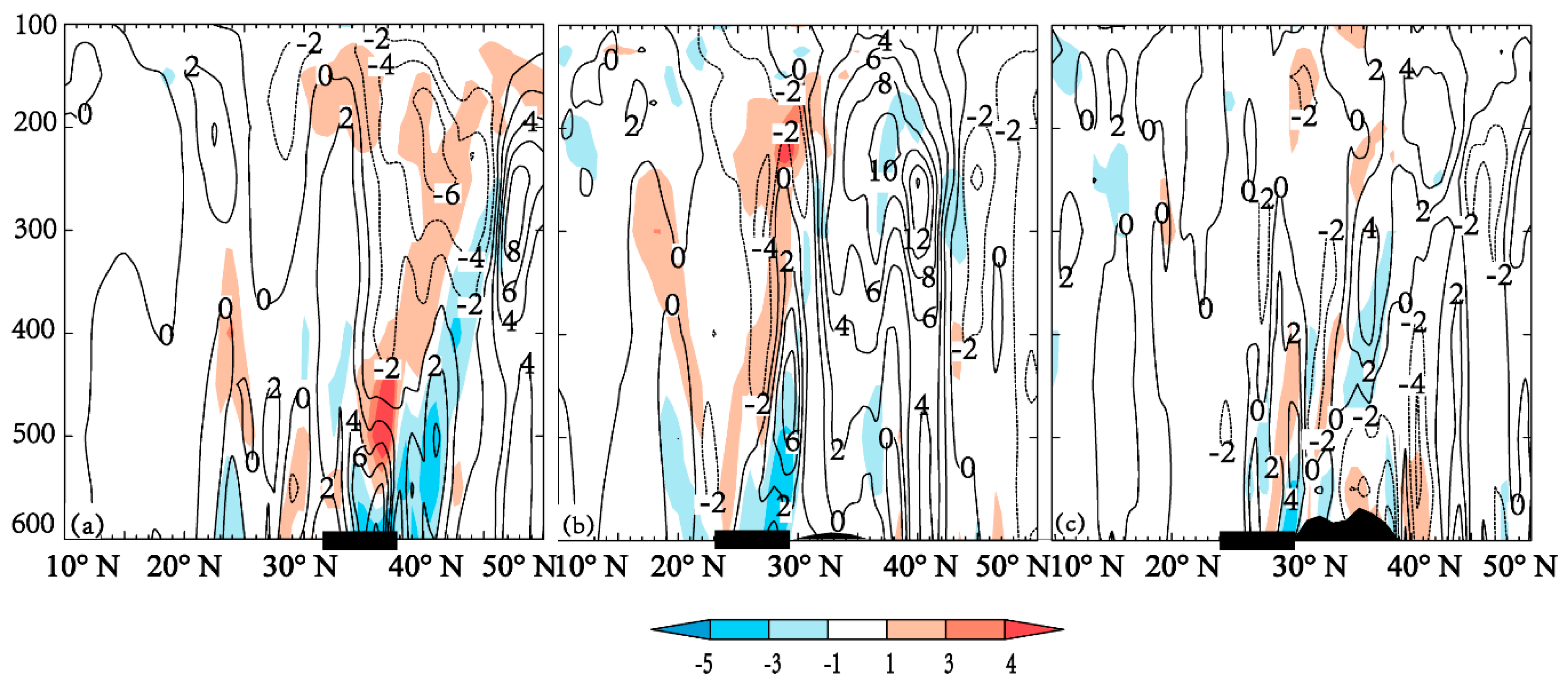
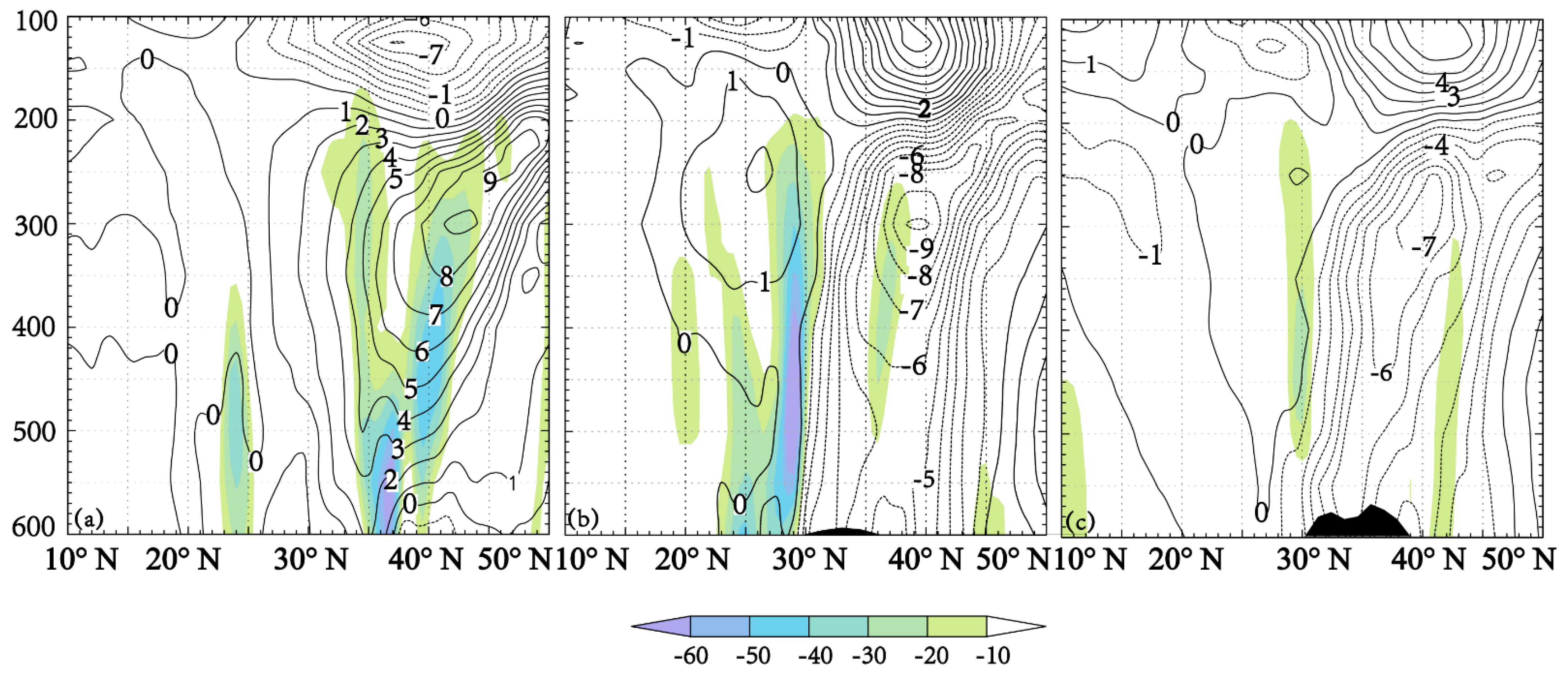

| Serial Number | Precipitation Area (Adjacent Stations) | Influence System | Case Time | Maximum Precipitation (mm) |
|---|---|---|---|---|
| 1 | E (4) | Plateau low trough | 19830818 | 39.8 |
| 2 | E (6) | Plateau low trough | 20160714 | 41.6 |
| 3 | N (6) | Plateau low trough | 19900725 | 37.5 |
| 4 | N (7) | Plateau low trough | 19970702 | 48.3 |
| 5 | N (4) | Plateau low trough | 19970805 | 42.0 |
| 6 | N (4) | Plateau low trough | 19980710 | 65.0 |
| 7 | N (5) | Plateau low trough | 19950810 | 44.5 |
| 8 | N (6) | Plateau low trough | 19960809 | 49.0 |
| 9 | N (5) | Plateau low trough | 20080730 | 38.9 |
| 10 | N (5) | Plateau low trough | 20090818 | 45.9 |
| 11 | N (7) | Plateau low trough | 20120730 | 48.0 |
| 12 | N (5) | Plateau low trough | 20010709 | 40.8 |
| 13 | N (5) | Plateau low trough | 20130827 | 52.6 |
| 14 | N (6) | Plateau low trough | 20140708 | 46.8 |
| 15 | N (5) | Plateau low trough | 20160710 | 46.6 |
| 16 | N (5) | Plateau low trough | 20160711 | 39.8 |
| 17 | E (5) | Plateau shear line | 19890727 | 115.8 |
| 18 | E (5) | Plateau shear line | 19930829 | 66.0 |
| 19 | E (5) | Plateau shear line | 19950703 | 39.9 |
| 20 | E (9) | Plateau shear line | 19970708 | 67.8 |
| 21 | E (4) | Plateau shear line | 20070721 | 44.5 |
| 22 | E (5) | Plateau shear line | 20100718 | 55.9 |
| 23 | S-C (5) | Plateau shear line | 19950704 | 34.2 |
| 24 | N (5) | Plateau shear line | 19930720 | 42.7 |
| 25 | N (5) | Plateau shear line | 20070830 | 60.5 |
| 26 | N (6) | Plateau shear line | 20100607 | 52.0 |
| 27 | N (5) | Plateau shear line | 20120605 | 93.7 |
| 28 | S-C (4) | Plateau vortex | 19900731 | 35.4 |
| 29 | S-C (5) | Plateau vortex | 19860716 | 35.9 |
| 30 | S-C (3) | Plateau vortex | 20130807 | 44.5 |
| 31 | S-C (6) | Plateau vortex | 20150819 | 75.9 |
| 32 | E (5) | Plateau vortex | 20000828 | 42.1 |
| 33 | N (4) | Plateau vortex | 19980709 | 35.4 |
| Year | Precipitation Period | Synthesis Time | Precipitation Type | Influence System |
|---|---|---|---|---|
| 1990 | 24 July–25 July | 24 July 18:00 | PT-type | Plateau low trough |
| 1995 | 09 Aug–10 Aug | 09 Aug 18:00 | PT-type | Plateau low trough |
| 2013 | 26 Aug–27 Aug | 26 Aug 18:00 | PT-type | Plateau low trough |
| 2014 | 07 July–08 July | 07 July 18:00 | PT-type | Plateau low trough |
| 1989 | 26 July–27 July | 26 July 18:00 | PSL-type | Plateau shear line |
| 1993 | 28 Aug–29 Aug | 28 Aug 18:00 | PSL-type | Plateau shear line |
| 1997 | 07 July–08 July | 07 July 18:00 | PSL-type | Plateau shear line |
| 2007 | 20 July–21 July | 20 July 18:00 | PSL-type | Plateau shear line |
| 1986 | 15 July–16 July | 15 July 18:00 | PV-type | Plateau vortex |
| 1990 | 30 July7–31 July | 30 July 18:00 | PV-type | Plateau vortex |
| 2013 | 06 Aug–07 Aug | 06 Aug18:00 | PV-type | Plateau vortex |
| 2015 | 18 Aug–19 Aug | 18 Aug 18:00 | PV-type | Plateau vortex |
Publisher’s Note: MDPI stays neutral with regard to jurisdictional claims in published maps and institutional affiliations. |
© 2021 by the authors. Licensee MDPI, Basel, Switzerland. This article is an open access article distributed under the terms and conditions of the Creative Commons Attribution (CC BY) license (http://creativecommons.org/licenses/by/4.0/).
Share and Cite
Sun, J.; Yao, X.; Deng, G.; Liu, Y. Characteristics and Synoptic Patterns of Regional Extreme Rainfall over the Central and Eastern Tibetan Plateau in Boreal Summer. Atmosphere 2021, 12, 379. https://doi.org/10.3390/atmos12030379
Sun J, Yao X, Deng G, Liu Y. Characteristics and Synoptic Patterns of Regional Extreme Rainfall over the Central and Eastern Tibetan Plateau in Boreal Summer. Atmosphere. 2021; 12(3):379. https://doi.org/10.3390/atmos12030379
Chicago/Turabian StyleSun, Jun, Xiuping Yao, Guowei Deng, and Yi Liu. 2021. "Characteristics and Synoptic Patterns of Regional Extreme Rainfall over the Central and Eastern Tibetan Plateau in Boreal Summer" Atmosphere 12, no. 3: 379. https://doi.org/10.3390/atmos12030379
APA StyleSun, J., Yao, X., Deng, G., & Liu, Y. (2021). Characteristics and Synoptic Patterns of Regional Extreme Rainfall over the Central and Eastern Tibetan Plateau in Boreal Summer. Atmosphere, 12(3), 379. https://doi.org/10.3390/atmos12030379





